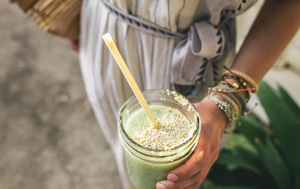The human body is host to over 100 million microbes – the bacteria, fungi, protozoa and viruses that live on and in our bodies. In fact, it is estimated that the total amount of microbes in the human body can weigh as much as 2kg! These microbes are found all over our skin and throughout our bodies but most live in our gut, with the majority in the large intestine (or bowel).
Article contributed by Dr Annette Creedon, Nutrition Manager at the British Nutrition Foundation.
As you may well have seen, they have attracted a significant amount of interest recently due to their impact on digestion and other possible roles in health. By helping to regulate hormones, breaking down dietary fibre to produce short chain fatty acids and supporting our immune systems they have been suggested to help reduce the risk of conditions including heart disease, diabetes and even depression.
Microbes are microorganisms that can only be seen under a microscope and this collection of bacteria, fungi, protozoa and viruses that live on and in the body is referred to as the human microbiota. There are localised differences in the microbiota depending on where in the body the microbiota is from, for example, an individual’s gut microbiota can be very different to their skin microbiota. The term microbiome refers to the collection of microbes and their genes, the environment they inhabit and the surrounding conditions within that environment. However, in practice, these terms are used interchangeably.
Where does the microbiome come from?
Although there is often concern that microbes can make people ill or cause food poisoning, a healthy microbiome contains bacteria that can be beneficial for our health. Each of us has a unique microbiome which some research suggests is influenced by our genetics. But it is well established that microbiome composition changes in the first few years of life and can be significantly influenced by mode of delivery at birth, breastfeeding, early antibiotic use, and timing and type of complementary feeding. The early years are therefore very important but as we move through life, our microbiome continues to be influenced, for example, by our geographical location, ageing, medication (especially antibiotics), our diet and lifestyle habits.
Diet and a healthy gut microbiome
We know that specific nutrients, foods and dietary patterns can influence the numbers and types of microorganisms in the gut. As a result, our diet is a key factor in helping us maintain a healthy gut microbiome throughout life.
Live bacteria are added to some foods (e.g. yoghurts) and drinks and can provide a boost to certain strains of bacteria in our gut. They can also be found in supplements. These ‘probiotics’ have health benefits if consumed in adequate amounts (e.g. helping to ease symptoms of traveller’s diarrhoea or diarrhoea during antibiotic use, as well as constipation or IBS), although only while you continue to take them. Some fermented foods, such as kefir, kombucha, sauerkraut, tempeh, natto, miso and kimchi naturally contain live cultures, the purported benefits of which have led to a surge in their popularity in recent years. Natural yoghurt can help lactose digestion in those that suffer from lactose intolerance. But any heat treatment can destroy live microbes in fermented foods, the quantity of microbes can be very variable and there is, as yet, limited evidence of beneficial health effects from most of these foods. Nevertheless, they can still be part of a healthy, balanced diet.
One of the most important ways to promote healthy gut bacteria is to eat a healthy, balanced diet containing a wide variety of fibre providing foods. Fibre is a type of carbohydrate that is not digested in the small intestine as it is resistant to our digestive enzymes. It therefore reaches the large intestine intact where it can be fermented and broken down by the microbiota. Fibre isn’t one specific compound; it’s a complex group of many compounds found in plant-based foods such as fruits, vegetables, wholegrains, beans and pulses. Some types of fibre are known as ‘prebiotics’ as they provide a physiological benefit to the individual and that benefit is at least partially resulting from some of the resident microbes using these dietary fibres as an important source of sustenance in our gut, leading to the production of short chain fatty acids and increasing the numbers of so called ‘good’ bacteria. These have been linked to a number of benefits such as increased absorption of minerals and water, and may be an important mechanism by which diets rich in fibre can help promote better health. Sources of these prebiotic fibres include vegetables, fruits, pulses and wholegrains which are typical constituents of healthier diets. These prebiotic fibres are used as functional ingredients and they can be isolated from these foods or they can be in synthesized forms.
On average, fibre intake in high income countries is low. In US it is reported that more than 90 percent of women and 97 percent of men do not meet recommended intakes for dietary fibre. On average, in the UK intakes of fibre hover around 20g a day, way below the 30g a day recommended for good health for adults. Improving the amount of fibre, and the range of plant foods consumed, is likely to promote gut bacterial diversity. One study, for example, found that people who ate more than 30 different plant-based foods each week had more diverse populations of microbes in their intestine than those eating less which the researchers suggested may be beneficial for gut health. In contrast, the adoption of restrictive diets, such as low carbohydrate diets, may not be a good approach when there is no clear medical need to follow them. There is some evidence that they can lead to profound changes in the microbiome, although the clinical relevance of these changes in healthy individuals in not yet clear.
Ultimately any dietary changes must be sustainable to achieve permanent alternations and to maintain a healthy gut microbiome, so our overall dietary pattern is key. For example, switching from a traditional western diet to a Mediterranean style diet, characterised by high intakes of fibre from foods such as cereals, vegetables, fruits and nuts, can lead to positive changes in the gut microbiome for healthy individuals as well as those with obesity, Type 2 diabetes and Crohn’s disease. Other dietary patterns such as vegetarian, vegan and plant-based diets which also include high intakes of fibre may also have similar benefits on gut health.
References:
Frese, S.A. and Mills, D.A. (2015). Birth of the infant gut microbiome: Moms deliver twice! Cell Host Microbe 17(5): 543-544.
Gibson GR, Hutkins R, Sanders ME et al. (2017). Expert consensus document: the International Scientific Association for Probiotics and Prebiotics (ISAPP) consensus statement on the definition and scope of prebiotics. Nature Reviews Gastroenterology and Hepatology 14: 491.
Hutkins, R. (2020). Fermented foods – separating hype from fiction [Webinar]. [Online]. British Nutrition Foundation. [Accessed 7 January 2022]. Available from: https://www.nutrition.org.uk/training-and-events/on-demand-webinars/
Lockyer, S. and Stanner, S. (2019). Prebiotics – an added benefit of some fibre types. Nutrition Bulletin 44: 74-91.
Scientific Advisory Committee on Nutrition. (2015). Carbohydrates and health. London: Scientific Advisory Committee on Nutrition.
Scott. K.P., Grimaldi, R., Cunningham, M., Sarbini, S.R., Wijeyesekera, A., Tang, M.L.K., Lee, J.C.-Y., Yau, Y.F. Ansell, J., Theis, S., Yang, S., Yang, K., Menon, R., Arfsten, J., Manurung, S., Gourineni, V. and Gibson, G.R. (2019). Developments in understanding and applying prebiotics in research and practice – an ISAPP conference paper. Journal of Applied Microbiology 128: 934-949.

Nutrition plays a key role in consumers’ lives
We address the health and nutritional needs of your consumers using our science-based innovative ingredient solutions. Discover how in our Nutrition Centre...

